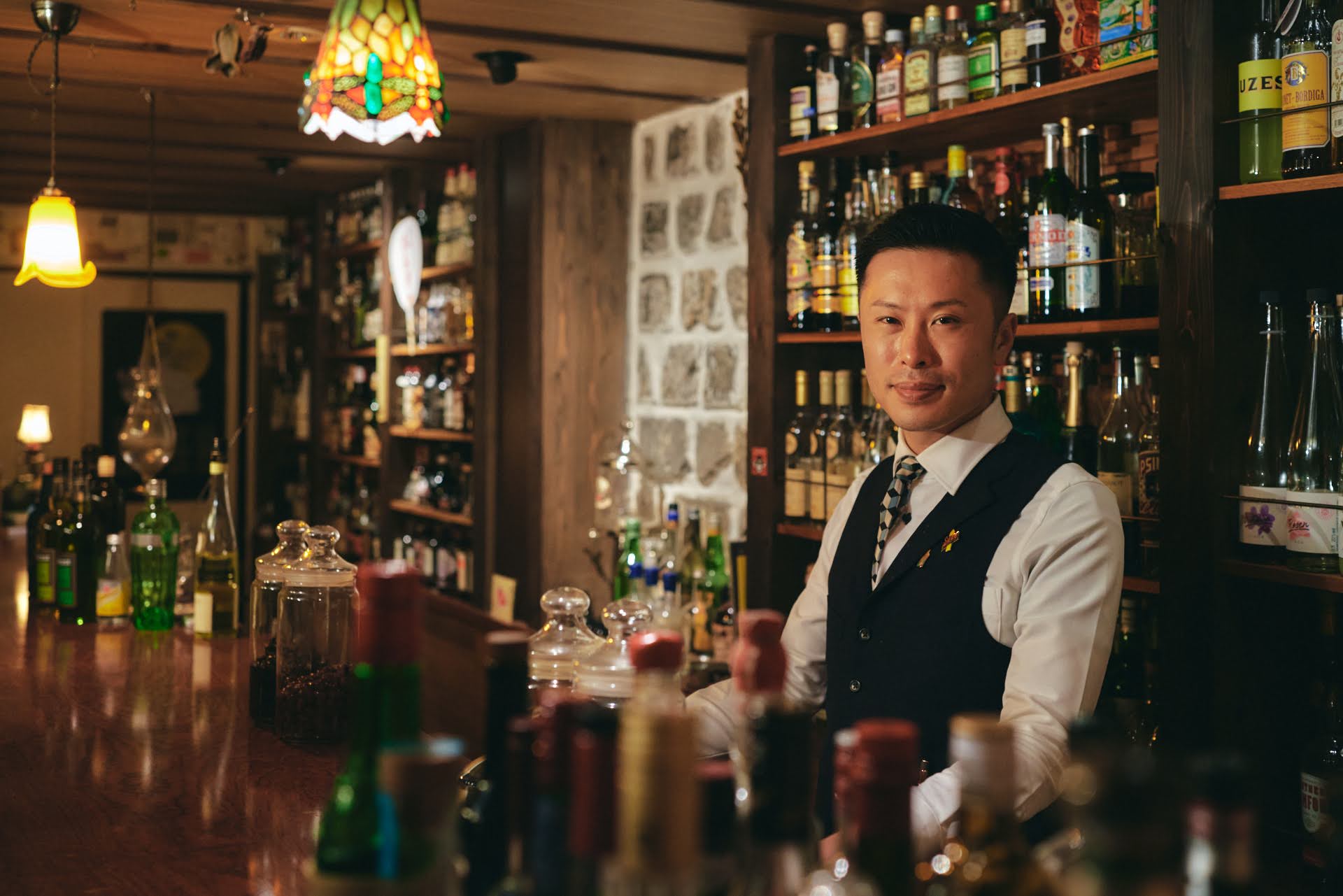Bar iXey is located near the Shirakawa River in Gion, Kyoto. They specialize in herbal liqueurs which are spirits infused with the aromas of various plants.
Besides Campari and a few other brands, herbal liqueurs are still not very popular in Japan. When I first visited Bar iXey as a customer I found the folk artsy interior space to be very comforting, but at the same time I felt a bit nervous because I didn’t recognize many of the bottles of liquor lined up in the back bar.
I told the bartender that I was unsure of what I should order and he asked me what I usually enjoy drinking. Then he selected several bottles of liqueurs and let me smell them one by one. I was very surprised to find that each had a very different and unique aroma, such as the smell of fresh green tree roots and soil. One had an aroma that was like burying your face in a bouquet of roses.
Based on the aromas, I told the bartender which drink I wanted to try. The cocktails and liqueurs he prepared for me were all exquisite and his graceful and courteous service made me sit taller in my seat. After my experience there, I found myself remembering and thinking about the aromatic drinks I experienced at Bar iXey often.
Herbal liqueurs are also known as perfumes for drinking. Understanding the depths of the world of herbal liqueurs may give us clues to deepen our exploration of shikohin and shikohin experiences.
We interviewed bartender Hiroaki Oda, the owner of Bar iXey and iXey Non-Alcoholic Spirits Kyoto, a bar and distillery that specializes in non-alcoholic spirits that opened in Kyoto in 2022, and asked him about his explorations surrounding herbal liqueurs.
What it means to order “something strong” and the difference between “taste” and “flavor”
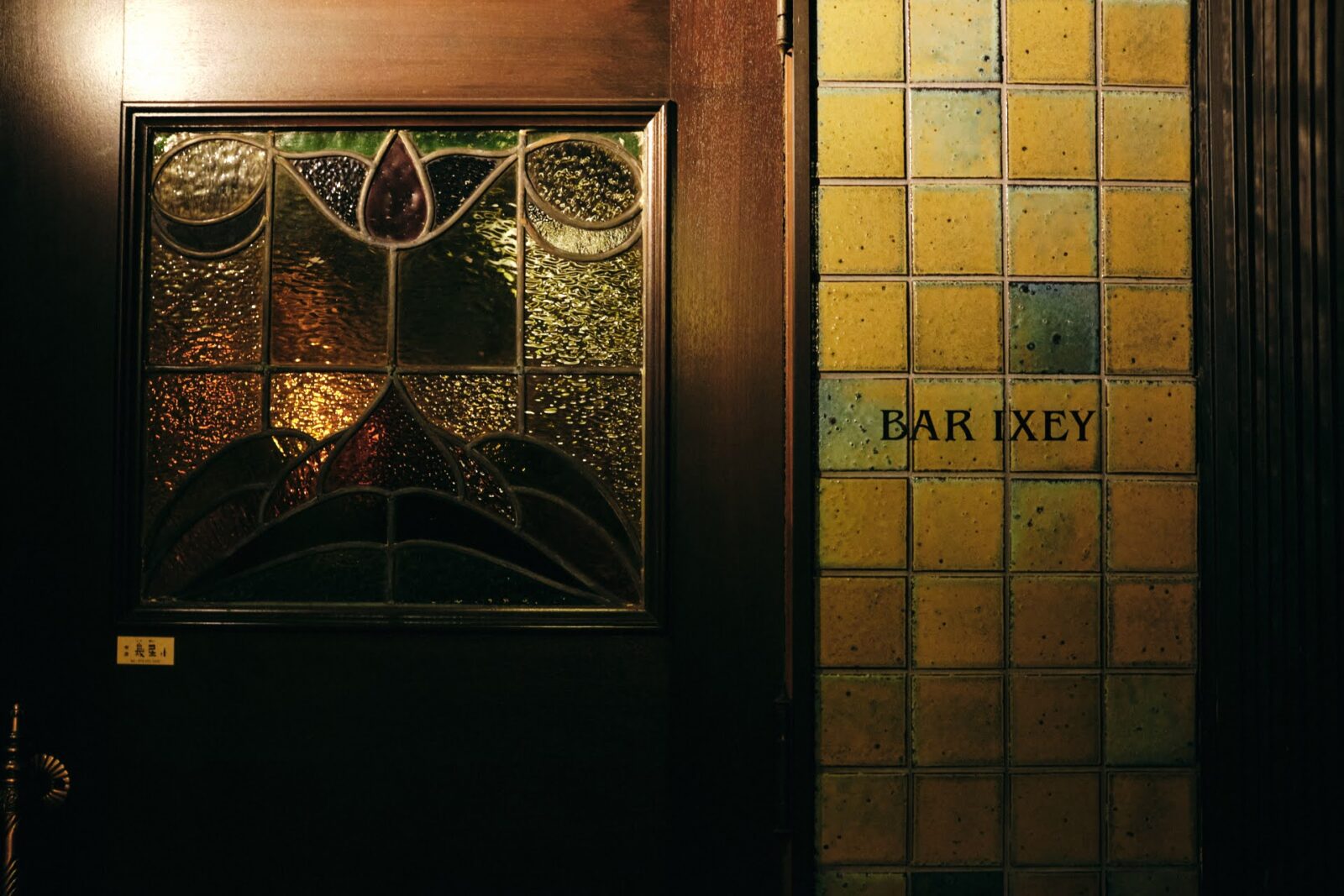
We visited Bar iXey on a September day when the summer heat was still strong in the air. Upon our arrival Oda prepared a cocktail for us.
We asked for a long cocktail with a woody aroma, and Oda recommended a Sapin liqueur (made in France) which is made by soaking fir tree buds.
I mentioned that I like the aroma of cedar and cypress trees and I enjoyed drinking a gimlet made with Sapin liqueur before. Oda thought about it for a few moments before preparing a Sapin-based cocktail flavored with two types of homemade bitters.
Aside from the Sapin and homemade bitters the cocktail was relatively simple, made with fresh lime juice, tonic water and soda.
It was a clear drink that looked like simple soda water and was not decorated in any way. However, the deep woody aroma of the drink filled the air before you even put your mouth on the glass. A mellow sandalwood aroma filled my mouth when I took a sip and it lingered in the back of my throat even after I finished the drink.
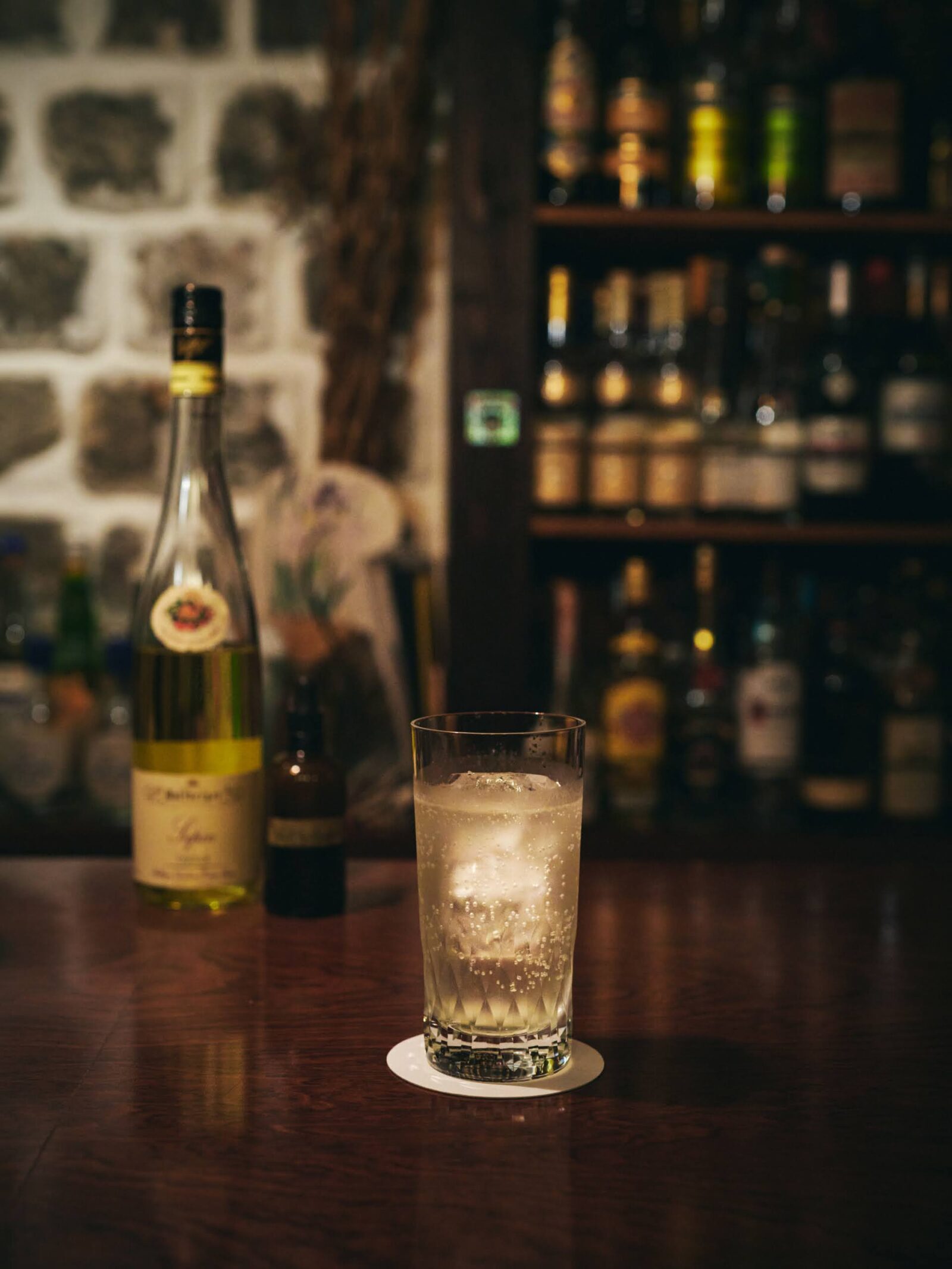
Oda says that when he is serving first-time guests, he often gets clues from people’s preferences in scents.
“Although it is case-by-case, I often ask first-time customers what kind of scents they like in addition to their usual preferences in alcoholic drinks.”
“One thing to keep in mind is that in Japanese, the Japanese word for taste (味:Aji) encompasses both the meaning of “flavor” and “taste” in English. In other words, in Japanese the concept of flavor includes the concept of aroma. This is why I explain to customers that we must first think of these two separately.”
Oda says that when he asks Japanese guests what their favorite scent is, 85% of them reply that it is citrus.
“When people say they like the scent of citrus, many of them mean that they like the taste of citrus and not necessarily just the scent. They say citrus because they like refreshing and sour flavors. However, this is more about the taste of something, rather than the flavor. In order to explain the difference, I usually ask them to think about a scent that is not usually consumed in the mouth, such as a scent used in cosmetics or perfumes, and have them imagine the aroma in that way.”
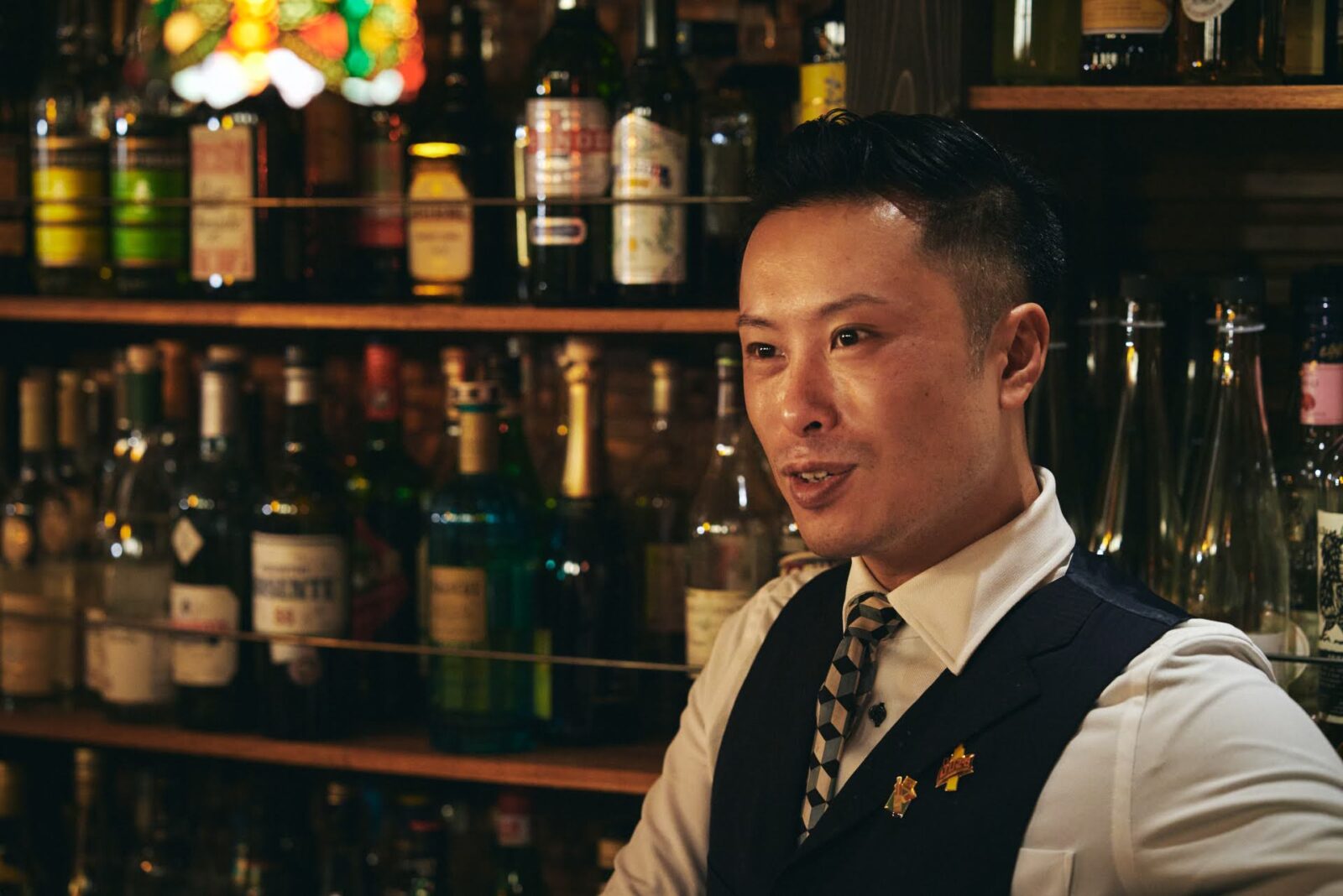
After getting a general idea of their scent preferences, Oda sometimes asks for further classification of preferred scents such as floral, green, cinnamon, vanilla and so on.
Because our impression of scents is largely individual, when someone makes the common request for “something strong” Oda is careful to decipher what that means.
“Liqueurs with a bitter taste that is like Chinese herbal medicines are usually what many people think about when imagining “something strong”. However, there are also people who find celery-like aromas “strong”. In fact, what gives a drink a “strong” impression is interpreted very differently by different people.”
“Considering this, perhaps it is best to serve what most people will consider “strong”, but there is no fun in that and it doesn’t leave any lasting impression. I try to assist the customer in identifying their preferences and then suggest a drink that would be both interesting and on point for them.”
The equation to creating a delicious cocktail and its limits
Oda has a unique method of creating cocktails.
Many bartenders create their cocktails around spirits (such as vodka, gin, rum, tequila, etc.) which acts as the “spirit” or “soul” of the drink.
The focus is often on the spirit itself and how to use it. Liqueurs are more often used as a supportive role to compliment the spirits.
For Oda, the opposite is true. He uses spirits to compliment the liqueur.
“One attraction is that there is a world of aromas that can only be brought out by sugar and this is not only true for herbal liqueurs but for all liqueurs in general.”
“When fruits and plants are added to the base spirit of the liqueur and sugar is added little by little, at a certain point the natural bitterness of the fruits and plants recedes and a rich aroma comes out in its place. I think that this is a world of aromas that only exists in the world of liqueurs and it is brought out by the power of sugar.”
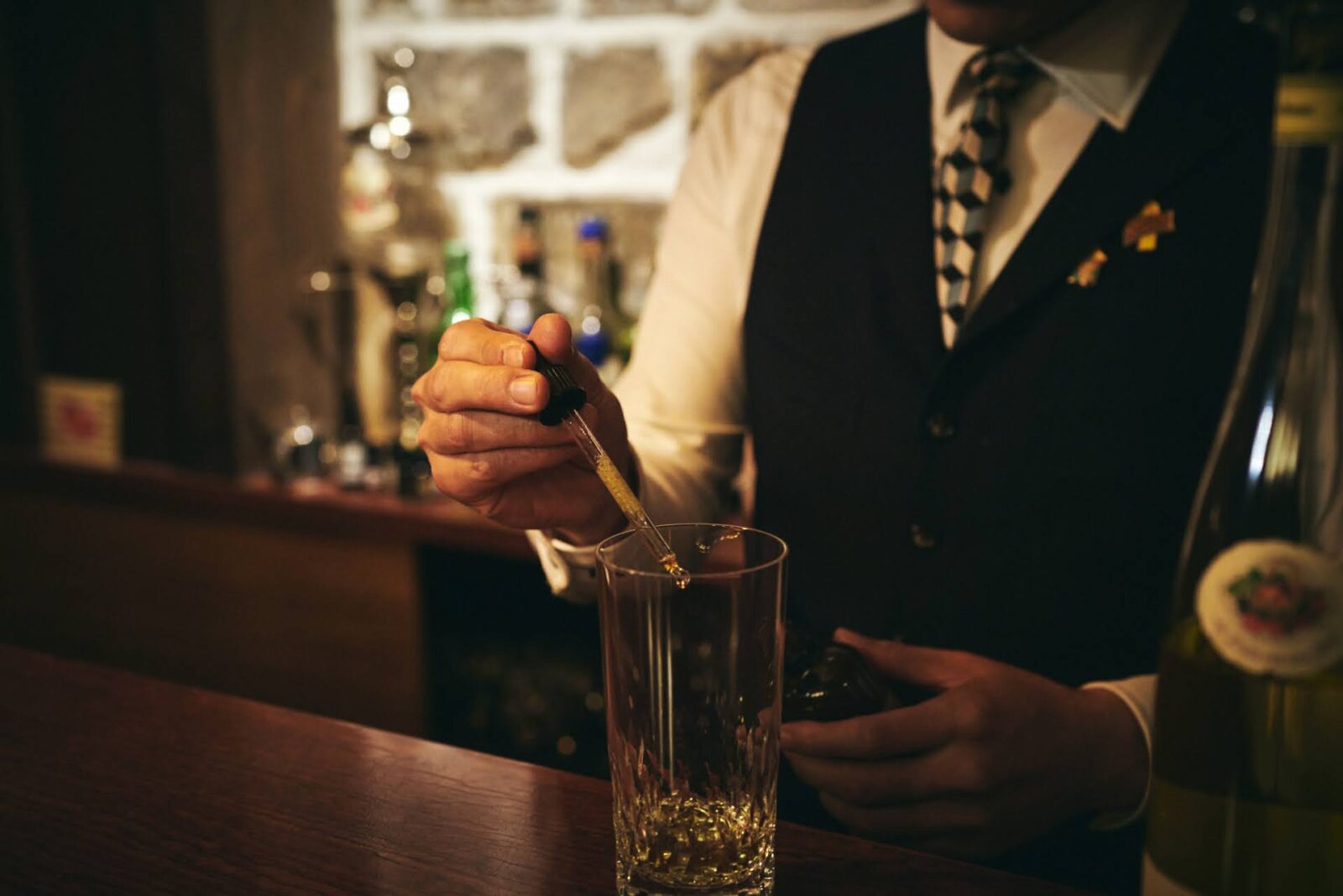
If one were to enjoy the delicate aroma of a liqueur it should be paired with a gin which has a lighter and fresher scent. If one were to use a liqueur with a strong scent like rosemary, a spirit with a distinct aroma such as tequila or mezcal can be used to balance the aroma.
“I think it is necessary to have knowledge of the equations behind flavors in order to make a good cocktail.”
“What makes it particularly interesting is that there are cases where a usually incompatible combination of tastes sometimes creates an unexpected harmony. For example, mixing red wine with a lot of tannin and acidic lemon juice is usually not good, but if you add a sweet syrup the two opposing tastes go well with each other. There are a lot of cocktails that apply to this principle.”
When Oda is thinking about flavor combinations he says that he uses scientific knowledge on how substances in ingredients react with each other, but only as supplemental information.
“Cocktails are not for scientifically analyzing substances, they are made to be tasted by the human palate. The last thing I want to do is to serve cocktails and act like I am absolutely sure it is delicious just because it is mixed in a certain way with certain ingredients. I think it is better to serve drinks while thinking that there is always room for improvement and this helps me build better relationships with my customers.”

Making cocktails like writing haiku
When asked about where he gets his inspirations for creating his cocktails, Oda says that he is often inspired from daily occurrences or natural scenery.
“I have been inspired by a sunset over Lake Biwa or seeing an autumn leaf be washed away into a drain on a rainy day. However, I do not try to link the colors and flavors of the cocktail with the scenery I have in mind. For example, I have been inspired by a beautiful stream of water, but I made the cocktail using a black liqueur.”
“Some people will see a stream of water and see beauty, while others may find it terrifying. Flowing water itself incites multiple different images. I am always thinking about how to express the multiple impressions I get from such scenery into my cocktails. There is no specific order I follow to make cocktails so it is difficult to describe in words, but perhaps it is similar to writing a haiku.”

Oda’s style of creating cocktails like writing haiku seems very unique. However, cocktail culture has historically been very connected to literature and art.
“Because of Instagram and Google Maps more people have found bars to be accessible in recent years so there has been an increase in customers. Of course, I think it is wonderful that we are reaching a wider audience.”
“On the other hand, I feel that some of the sex appeal that cocktail culture had before is being lost because people are choosing bars based solely on online reputation now.”
“In the past, many people came to bars to experience a drink or scene that a character portrayed in a novel, but people do not drink that way anymore. I think one challenge we are facing today is how we can bring back that kind of sex appeal in modern bars.”

A history that dates back to the 14th century and the profound world of herbal liqueurs
Bar iXey opened in 2014.
Before opening Bar iXey, Oda worked at several restaurants while aspiring to become a lawyer after he graduated from a university in Kyoto. A part-time job at a Spanish bar introduced him to the bar world and he started exploring various establishments after.
It was at this time that he felt particularly attracted to herbal liqueurs.
“There was a bar in Kyoto City that served Chartreuse and Izarra (a herbal liqueur produced in Basque, France). The experience of tasting these delicious drinks led me to want to explore the world of herbal liqueurs further so I decided to start my own establishment.”
“I think my desire to serve drinks that are different from other places partly comes from my personality. (laughs) About 15 years ago, very few people in Japan drank herbal liqueurs so I don’t think there were any other bars that specialized in herbal drinks.”
Oda says that it was easier to get into the herbal liqueur world because there was less variety compared to whiskey or wine. There were only about 30 to 40 types of herbal liqueurs in circulation in Japan at the time so he was able to try almost all of them within one year.
“Even wine, which is very much loved by Japanese people today, was once considered a cheap drink that was not favored by many people. Regardless of that history, our predecessors worked hard to promote the appeal of wine and they developed the wine culture into what it is today. I hope to do the same for herbal liqueurs.”

Although there are not as many varieties, Oda says that herbal liqueurs have a very long history.
“Modern liqueurs are said to have roots in 11th century Europe, where the first records of distilled alcohol were found. It is said to have spread mainly through monasteries from around the 14th century.”
“The properties of distilled spirits themselves are still shrouded in mystery, and in the 14th century they were described as mysterious water that ignites fire. Back then, the monasteries also acted as research institutions for alcohol. It was believed that the herbal liqueurs made there possessed some kind of spiritual power.”
“Herbal liqueur research began to decline as modern science developed in the 17th century, but eventually the herbal liqueurs began to be valued again for their medicinal properties and health benefits.”
New liqueur makers also began to emerge around this time. It is said that many of the herbal liqueur makers today were founded in the mid to late 1800s.
“However, there was a cocktail boom that happened in the late and early 20th century that saturated the herbal liqueur market. Herbal liqueurs have experienced numerous ups and downs throughout its history, but this also means that the herbal liqueurs that remain today have stood the test of time.”
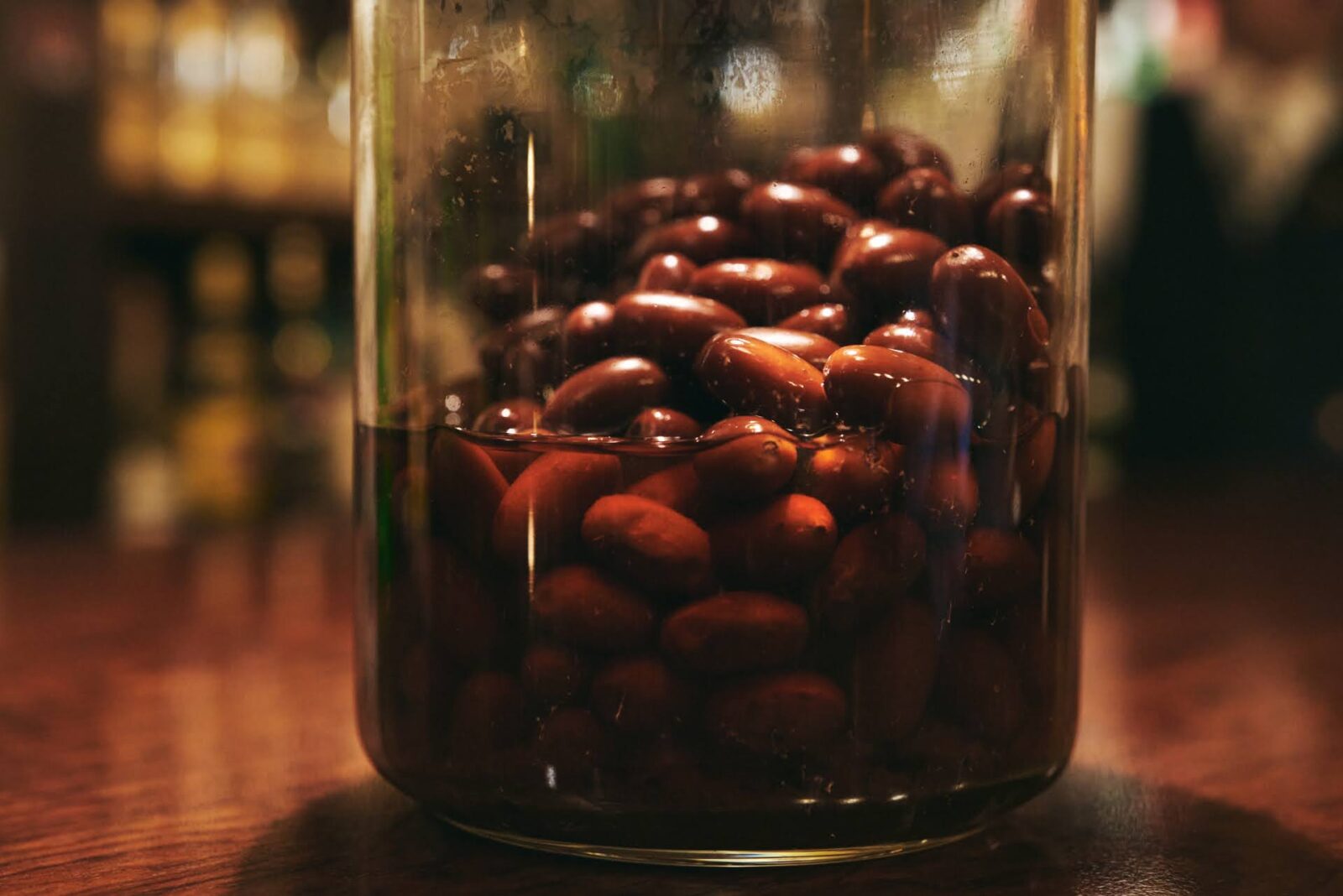
The requirements for non-alcoholic cocktails
In December 2022, Oda opened a second bar in the Kikuhama area of Kyoto.
The iXey Non-Alcoholic Spirits Kyoto is a non-alcoholic drink and cocktail bar with a distillery that specializes in non-alcoholic spirits. Customers can enjoy a variety of non-alcoholic beverages, such as a cocktail made with “miatina”, an original non-alcoholic spirit.
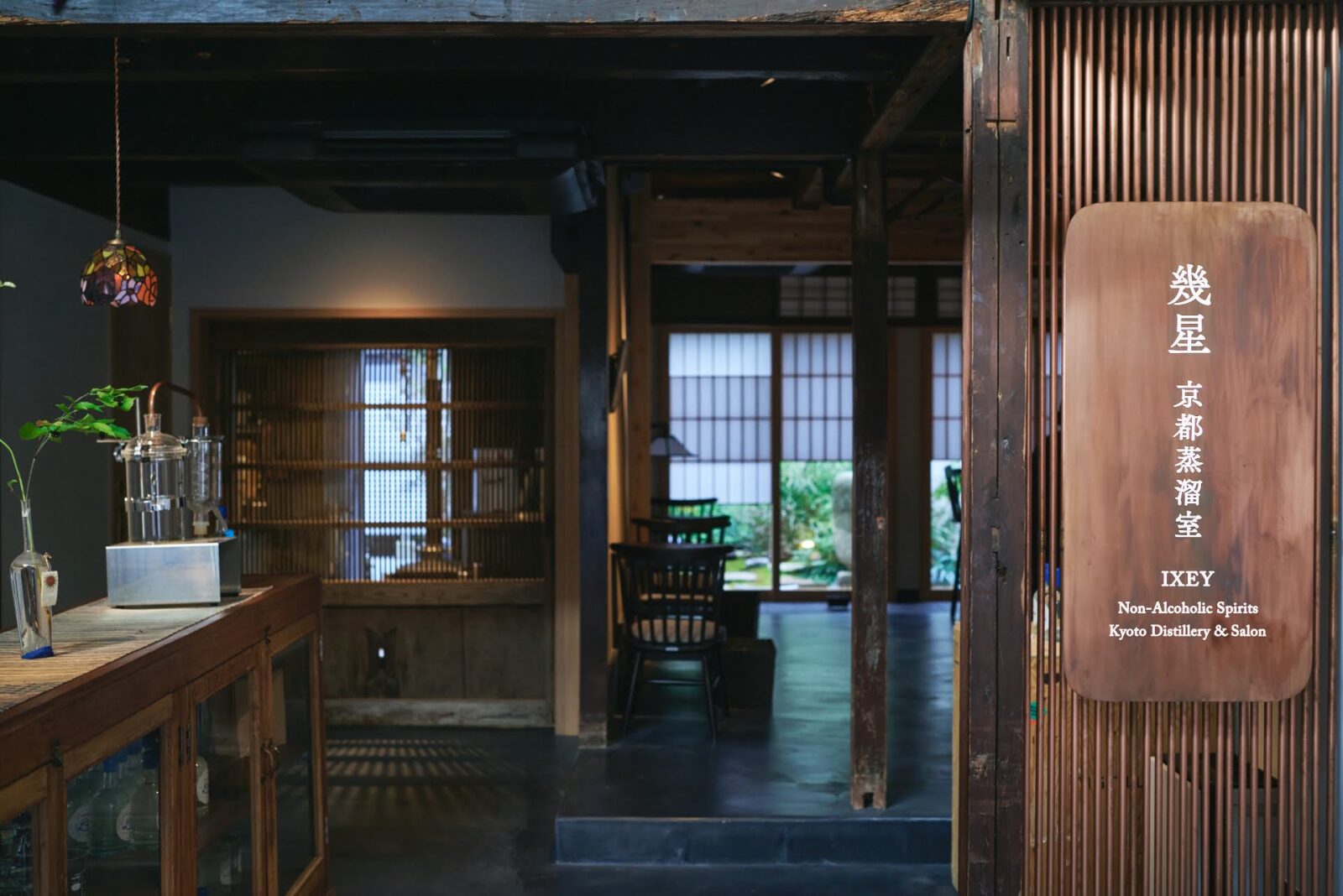
During the coronavirus pandemic there were restrictions in serving alcohol so Oda began serving non-alcoholic spirits. At this time many of his customers commented how they enjoyed the same uplifting experience with his non-alcoholic drinks that they get from regular drinks.
There are times when we experience a similar feeling of elation to that of drinking alcohol when we drink a good non-alcoholic cocktail. We asked Oda why this was and he explained what makes non-alcoholic cocktails an enjoyable cocktail.
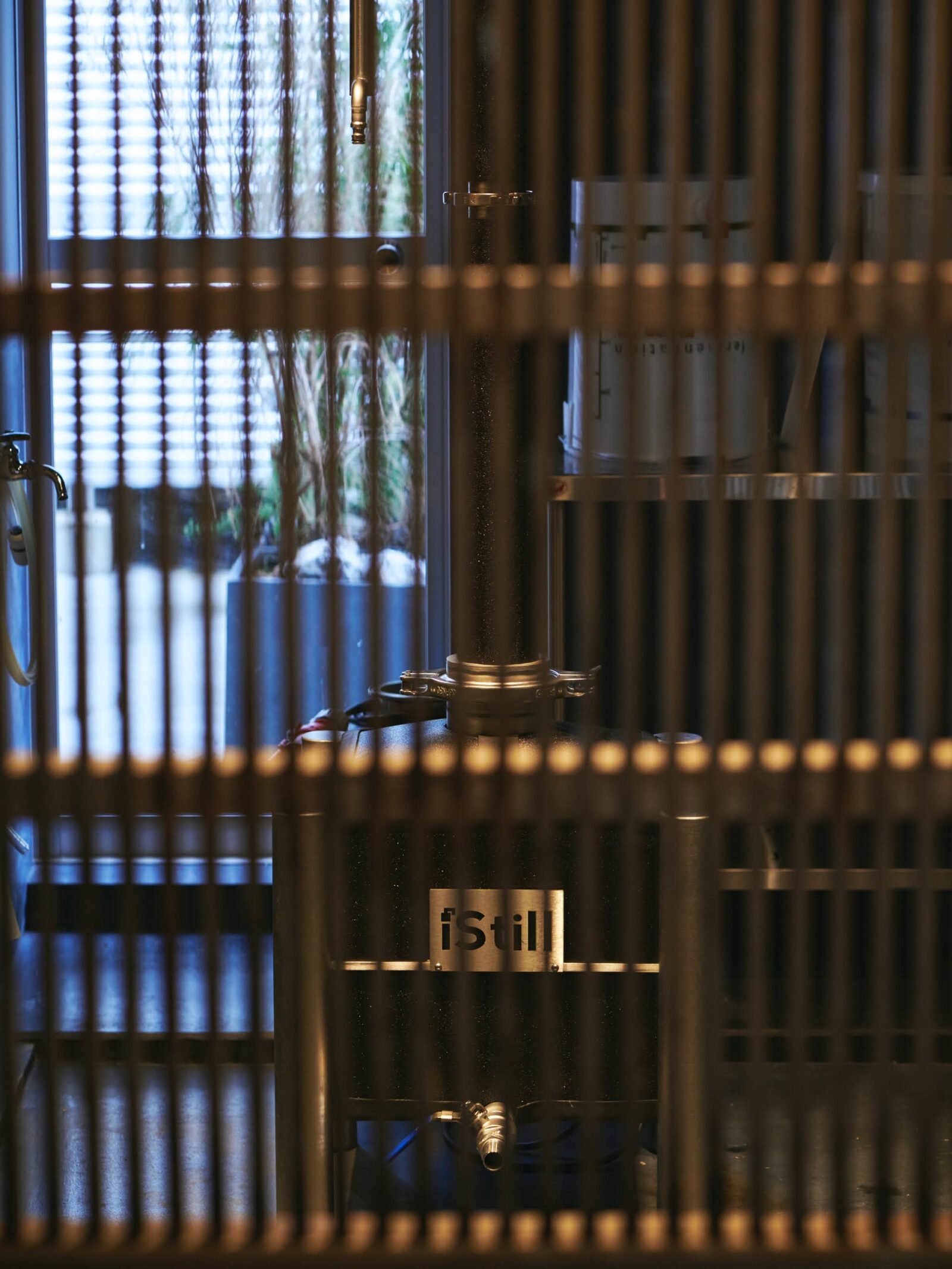
“I think the secret is in the concentrated aroma and bitterness of the drink. Without these two elements, a non-alcoholic drink is just a delicious juice or soft drink. This is why I add bitterness from my home-made bitters to the fragrant non-alcoholic spirits to make a drink that gives a closer experience to an alcoholic cocktail.”
“Adding the two elements of concentrated aroma and bitterness causes one to take longer to finish the drink. You cannot drink it in five minutes like you would a soft drink.”
“Conceptually speaking, I understand cocktails as a drink that leads to the creation of time.”
“Because it takes a while to finish the drink, it gives us the opportunity to share a moment of time together. I think non-alcoholic cocktails must be a drink that can turn something that may only take five minutes into an experience that can extend to 40 minutes or an hour.”
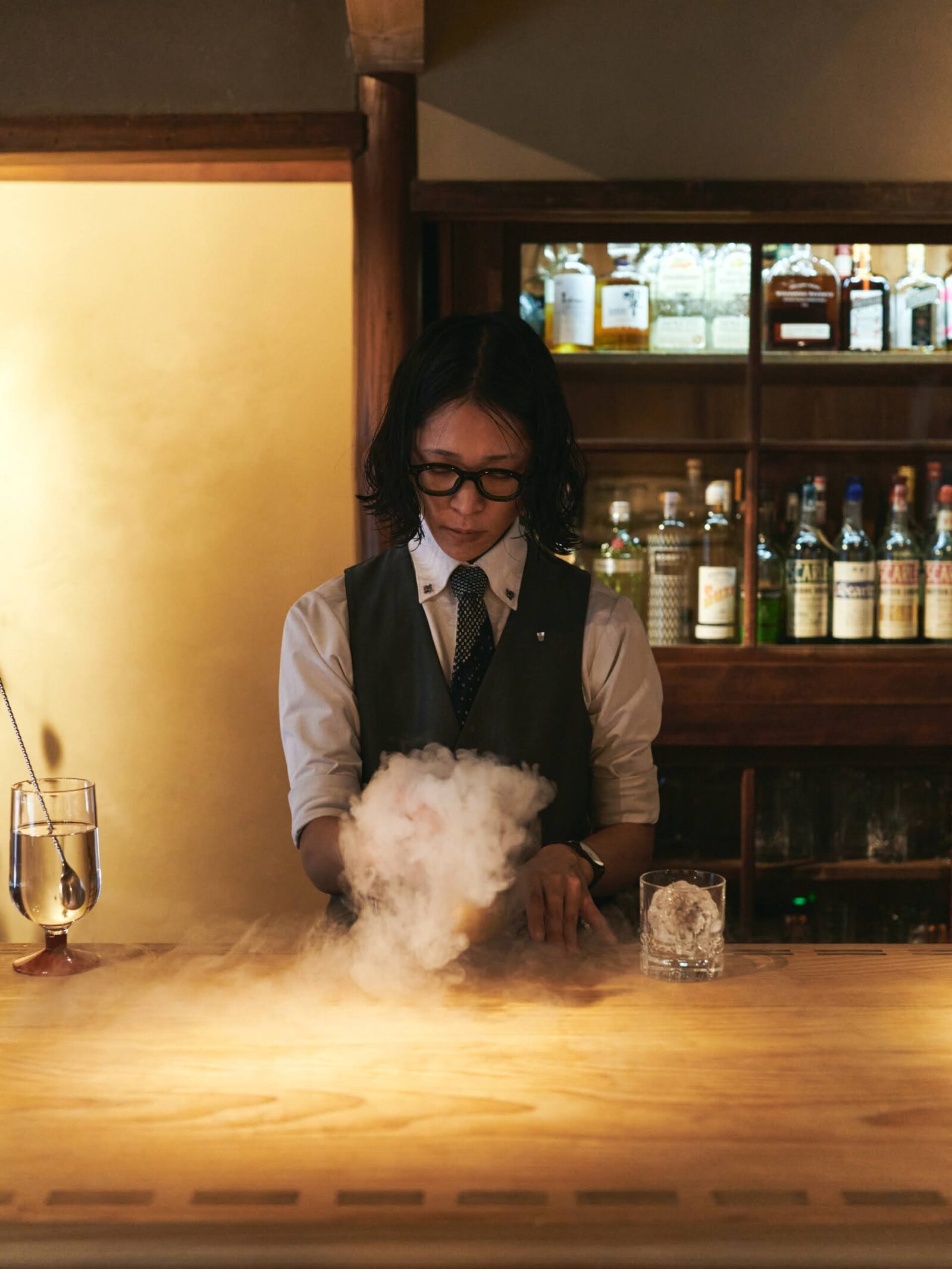
There is no such thing as the “ultimate cocktail”
There is a fine balance between logic and artistic perspective when Oda talks about how he makes cocktails, his stance towards service and his thoughts on bar culture itself.
This is also evident in his answer to the question on what makes herbal liqueurs so unique and interesting.
“Perhaps the correct answer would be to say that there is a meditative effect that is unique to herbal liqueurs, but I personally don’t really think so. (laughs) Whether the drink in front of you is herbal liqueur or wine or whisky, it only seems different because we are looking at it through the perspective of people who lived in different generations of time. However, I don’t think they are all that different at all.”
“Perhaps it is not good to say that it makes no difference, but regardless of what drink it is, when a bartender serves a customer a drink at the bar there is unique tension that arises and a conversation starts regarding the drink that is being served. I think it is these moments that give meaning to the bar experience.”
“Of course, the drink has to be delicious and there is a minimal amount of courtesy that should be present. However, I don’t think there is such a thing as an ultimate cocktail. ”
“If there is such a thing, it only exists in the relationship with the customer. This requires some sacrifice on the part of the customer because there has to be some communication and the bar owner must answer to that.”
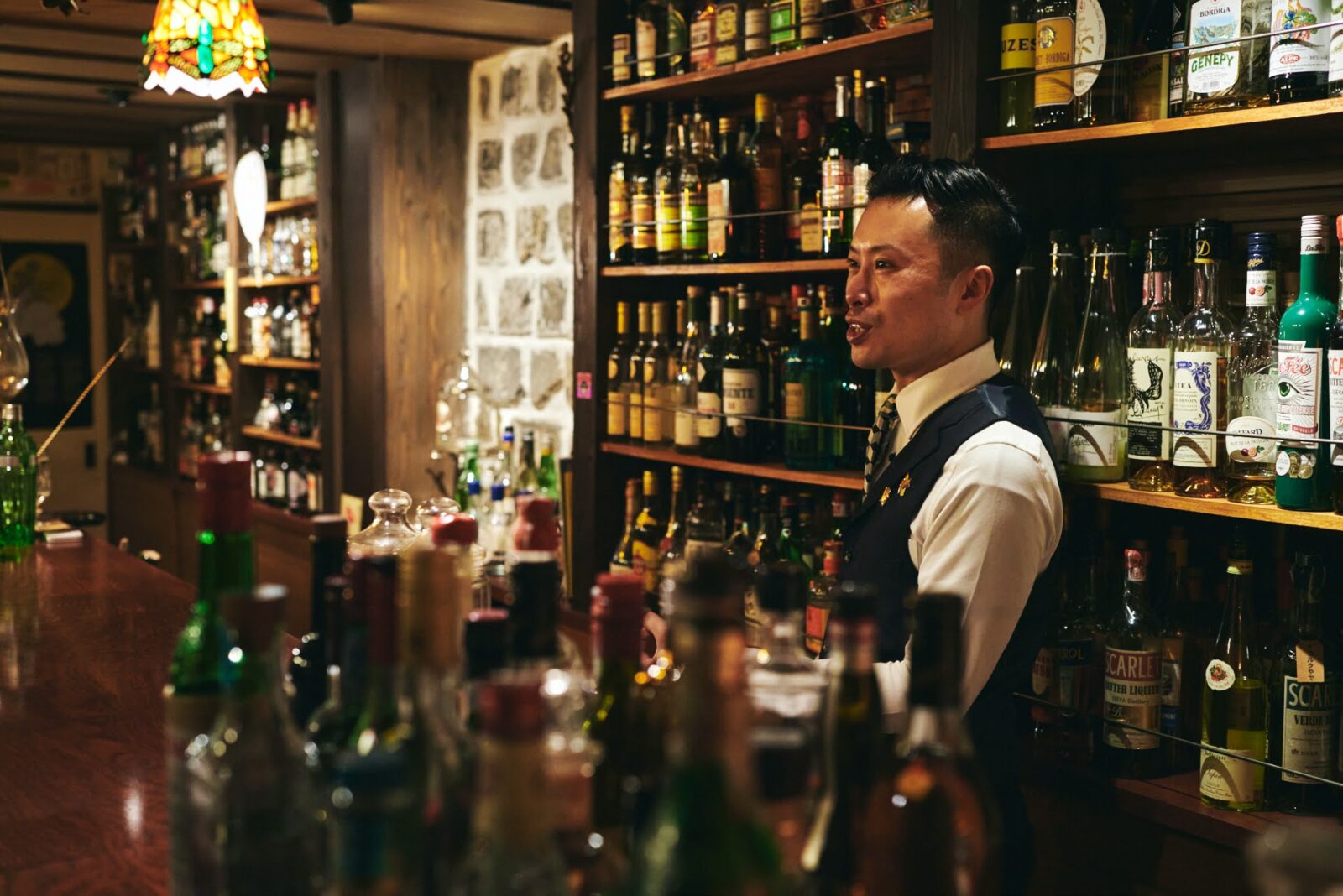
Oda insists that “absolute deliciousness can only exist through communication.” Because of this he also suggests, “If you find a bar that you like in your town or neighborhood, please try going there regularly for a few years.”
The experience that can be had when new customers and regular customers share a moment at the bar counter cannot be had by going to a famous bar that is only visited by non-regular and new customers.
Oda hopes that people will enjoy a bar in continuity with enjoying the neighborhood. When Oda talked about this, I remembered some of my favorite bars that I have visited in the past. At the same time, I could not help but feel joy in the presence of this bar that exists quietly in the beautiful streets of Gion, Kyoto.

Lives in Tokyo. Freelance writer and essayist, writing essays and interviews mainly for web media. Her short story “It’s me, I can hear you” was published in “Bessatsu Bungeishunju”. She also writes a series of essays for “Otekomachi”.
Editor, Writer, etc., for PLANETS, designing, De-Silo, MIMIGURI, and various other media.
